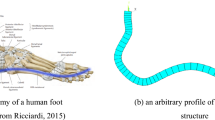Abstract
A multicriteria optimization model is developed to obtain the optimal geometry of the femoral component of a hip prosthesis. The objective function minimizes both the relative tangential displacement and the contact normal stress. For cementless stems, these two factors are relevant for the prosthesis stability and therefore for the implant success. The three-dimensional optimization procedure developed allows us to characterize the stem shape that minimizes displacement and stress individually, or simultaneously using a multicriteria approach. Design variables characterize successive stem sections, and are subjected to linear geometric constraints to obtain clinically admissible geometries. Multiple loads are considered to incorporate several daily life activities. The system bone–stem is considered a structure in equilibrium with contact condition on the interface. Results show that thin stem tips minimize the interface stress while collared stems minimize displacement. The multicriteria formulation leads to balanced solutions.
Similar content being viewed by others
References
ABAQUS (2003) ABAQUS, version 6.4. HKS, RI, USA
Bernakiewicz M, Viceconti M, Toni A (1999) Investigation of the influence of periprosthetic fibrous tissue on the primary stability of uncemented hip prostheses. In: Middleton J, Jones ML, Shrive NG, Pande GN (eds) Computer methods in biomechanics & biomedical engineering—3. Gordon and Breach, NY, USA, pp 21–26
Bruyneel M, Duysinx P, Fleury C (2002) A family of MMA approximations for structural optimization. Struct Multidiscipl Optim 24:263–276
Dorr LD, Wan Z (1996) Comparative results of a distal modular sleeve, circumferential coating, and stiffness relief using the anatomic porous replacement II. J Arthroplast 11(4):419–428
Fernandes PR, Rodrigues H, Jacobs C (1999) A model of bone adaptation using a global optimization criterion based on the trajectorial theory of Wolff. Comput Methods Biomech Biomed Eng 2:125–138
Fernandes PR, Folgado J, Jacobs C, Pellegrini V (2002) A contact model with ingrowth control for bone remodelling around cementless stems. J Biomech 35:167–176
Fernandes PR, Folgado J, Ruben RB (2004) Shape optimization of a cementless hip stem for a minimum of interface stress and displacement. Comput Methods Biomech Biomed Eng 7(1):51–61
Fung YC (1993) Biomechanics: mechanical properties of living tissues, 2nd edn. Springer, Berlin Heidelberg New York
García JM, Doblaré M, Cegoñino J (2002) Bone remodelling simulation: a tool for implant design. Comput Mater Sci 25:110–114
Herzwurm PJ, Simpson S, Duffin S, Oswald SG, Ebert FR (1997) Thigh pain and total hip arthroplasty. Clin Orthop Relat Res 336:156–161
Huiskes R, Boeklagen R (1989) Mathematical shape optimization of hip prosthesis design. J Biomech 22:793–804
Huo MH, Martin RP, Zatorski LE, Keggi KJ (1995) Total hip arthroplasty using Zweymuller stem implant without cement. J Arthroplast 10(6):793–799
Katoozian H, Davy DT (2000) Effects of loading conditions and objective function on three-dimensional shape optimization of femoral components of hip endoprostheses. Med Eng Phys 22:243–251
Keaveny T, Bartel D (1993) Effects of porous coating, with and without collar support, on early relative motion for a cementless hip prosthesis. J Biomech 26(12):1355–1368
Kowalczyk P (2001) Design optimization of cementless femoral hip prostheses using finite element analysis. J Biomech Eng 123:396–402
Kuiper JH (1993) Numerical optimization of artificial joint designs. Ph.D. thesis, Katholieke Universiteit Nijmegen
Luenberger DG (1989) Linear and nonlinear programming, 2nd edn. Addison-Wesley, Reading, MA
Mandell JA, Carter DR, Goodman SB, Shurman DJ, Beaupré GS (2004) A conical-collared intramedullary stem can improve stress transfer and limit micromotion. Clin Biomech 19:695–703
Osyczka A (1992) Computer aided multicriterion optimization system (CAMOS) software package in Fortran. International Software Publishers, Cracow, Poland
Rancourt D, Shirazi-Adl A, Drouin G, Paiment G (1990) Friction properties of interface between porous-surfaced metals and tibial cancellous bone. J Biomed Materi Res 24:1503–1519
Romagnoli S (2002) Press-fit hip arthroplasty, a European alternative. J Arthroplast 17(4 Suppl 1):108–112
Svanberg K (1987) The method of moving asymptotes—a new method for structural optimization. Int J Numer Methods Eng 24:359–373
Svanberg K (1995) A globally convergent version of MMA without linesearch. In: Olhoff N, Rozvany GIN (eds) First world congress of structural and multidisciplinary optimization. Pergamon, Oxford, pp 9–16
Swanson TV (2005) The tapered press fit total hip arthroplasty. J Arthroplast 20(4 Suppl 2):63–67
Viceconti M, Casali M, Massari B, Cristofolini L, Bassani S, Toni A (1996) The ‘standardized femur program’ proposal for a reference geometry to be used for the creation of finite element methods of the femur. J Biomech 29:1241
Viceconti M, Monti L, Muccini R, Bernakiewicz M, Toni A (2001) Even a thin layer of soft tissue may compromise the primary stability of cementless hip stems. Clin Biomech 16:765–775
Yoon YS, Jang GH, Kim YY (1989) Shape optimal design of the stem of a cemented hip prosthesis to minimize stress concentration in the cement layer. J Biomech 22:1279–1284
Zuo KT, Chen LP, Zhang YQ, Yang J (2005) A hybrid topology optimization algorithm for structural design. Eng Optim 37(8):849–866
Author information
Authors and Affiliations
Corresponding author
Rights and permissions
About this article
Cite this article
Ruben, R.B., Folgado, J. & Fernandes, P.R. Three-dimensional shape optimization of hip prostheses using a multicriteria formulation. Struct Multidisc Optim 34, 261–275 (2007). https://doi.org/10.1007/s00158-006-0072-4
Received:
Revised:
Published:
Issue Date:
DOI: https://doi.org/10.1007/s00158-006-0072-4




